ASUS UX31A: Putting the Ultra in Ultrabooks
by Jarred Walton on August 28, 2012 9:00 AM EST- Posted in
- Laptops
- Intel
- Asus
- Ivy Bridge
- Zenbook Prime
- Ultrabook
ASUS UX31A: Gaming Performance
First, let’s get this out of the way: this page is only for those who are interested/curious about gaming potential. If you’ve seen any of our previous looks at Intel’s HD 4000 GPU performance, you should already know what to expect. Intel can now run DX11 titles, but in practice you’ll need to use a lower resolution (e.g. the ever-so-popular 1366x768, or even 1280x720) with low to medium detail settings. Even then, some titles are simply too demanding for HD 4000. If you can wait another year, Haswell is supposed to double down on HD 4000 performance, but the waiting game isn’t very fun to play. We’re only going to show gaming results at our Value (~Medium 1366x768) settings, but if you want to see what happens at higher quality settings we’ve included Mainstream (~High 1600x900) results in Mobile Bench.
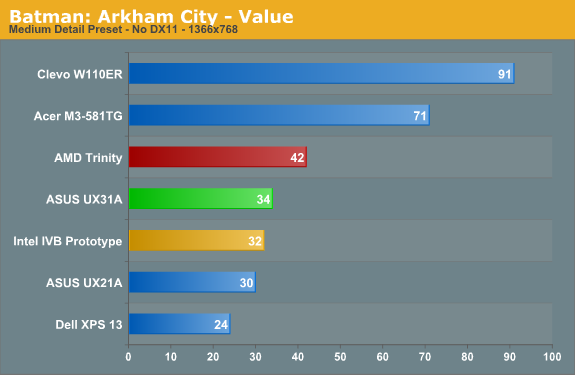

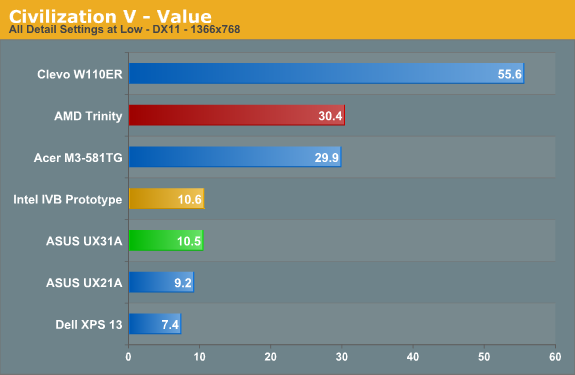
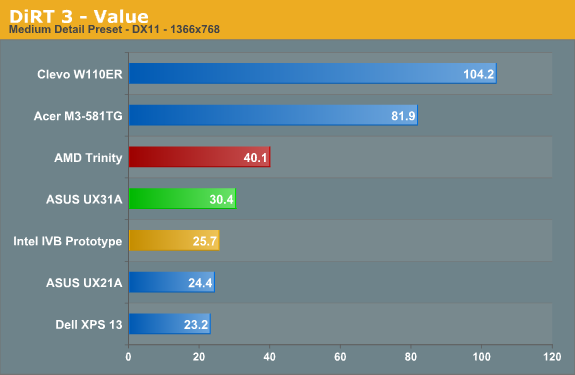
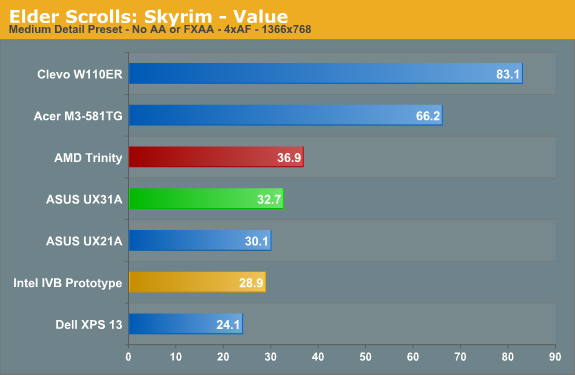
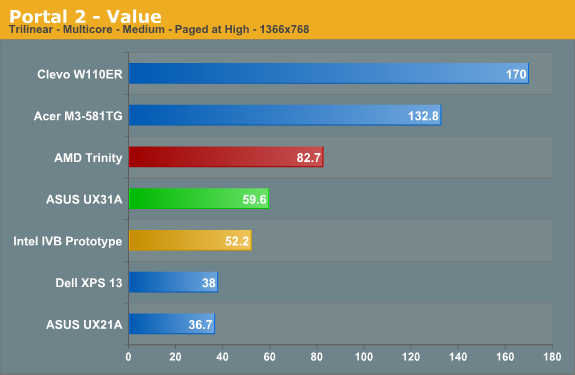
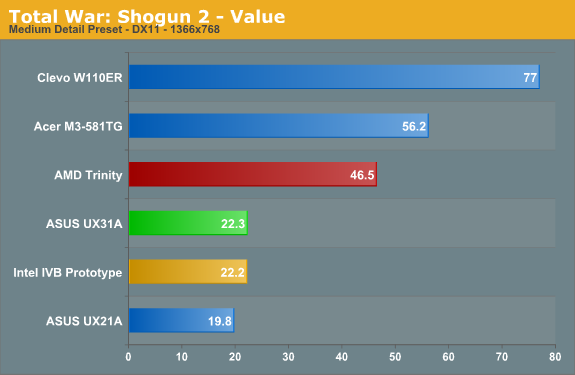
Much like the prototype IVB Ultrabook, the UX31A proves to be somewhat less capable than the standard voltage IVB parts when it comes to gaming. We still manage to pull playable frame rates in Batman, DiRT 3, Portal 2, and Skyrim, but even with average frame rates above 30FPS you’ll still see occasional dips into the low 20s or even the teens. At the native 1080p resolution, only Portal 2 is able to stay above 30FPS average, but I don’t think anyone really expected 1080p gaming to be a priority. In short, it’s possible to play some games on an Ultrabook without a dedicated GPU, but the experience won’t be all that great in many recent titles. AMD's Trinity on the other hand puts in a very respectible showing, with the understanding that the Acer M3 (and the newer M5) pretty much beat the A10 on all fronts.
At this point, we probably won't bother returning to look at Ultrabook gaming performance until something changes on the IGP (other than for discrete GPU models). We've exhaustively tested IVB ULV twice now, and the results are largely the same, other than a few minor differences that we can chalk up to drivers. If you want to know how Core i5/i7 ULV Ivy Bridge perform, the results above should tell you everything you need to know.










106 Comments
View All Comments
JarredWalton - Tuesday, August 28, 2012 - link
I didn't see any stickers, so you should be able to remove the HSF with a bit of effort. I didn't try to do this but the screws are easily accessible. I should note that I tried to disconnect the battery plug and gave up for fear of breaking something, though, so maybe it won't be so easy. LOLj_c - Tuesday, August 28, 2012 - link
"and stay away from the SanDisk U100 if you want decent SSD performance"More details on that particular issue would be nice.
Do you know a way to distinguish between these two models?
JarredWalton - Tuesday, August 28, 2012 - link
AFAIK, ASUS is not shipping the U100 any longer because of the performance issues. You can see where the UX31E and UX21A (with U100) rate in the PCMark 7 Storage suite -- basically the slowest SSD solution we've tested recently. What I don't know is whether ASUS figured out something with the ADATA SF-2281 firmware; I never experienced errors, but the BSOD issue still remains on some laptops/desktops.j_c - Thursday, August 30, 2012 - link
Very interesting, because over here in Germany, it seems the Sandisk model is the only one available. One commenter on amazon.de cites a call by Asus Customer Support, that no ADATA models will be available for now.JarredWalton - Saturday, September 8, 2012 - link
Apparently there are plenty of U100 equipped units shipping; I've updated the conclusion.Shadowmaster625 - Tuesday, August 28, 2012 - link
Can anyone make an educated guesstimate on how much a typical ultrabook would cost if it included this specific display, only a 128GB SSD, 4GB of RAM and the cheapest trinity A8?JarredWalton - Tuesday, August 28, 2012 - link
How much to make or how much it would sell for? In terms of BoM costs, it would probably be around $100 less than the Core i5 version ASUS is selling right now. Retail pricing is the real question. Right now, HP's Sleekbook 6z-1000 sells for $225 less than the Intel i5-3317U variant, but that's also with the A6-4455M which would be substantially slower than full voltage A8. The A10-4655M ought to be reasonably fast in graphics vs. Intel ULV, but we haven't been able to test it and it's $100 more than the A6 version ($125 less than Intel).The big problem is that no one is making 13.3" AMD-based "sleekbooks" that I know of -- links if you have them, please. And in fact, their AMD Sleekbooks are the worst thing I can think of: a 15.6" 1366x768 display with an ultra-thin form factor. Do people want 15.6" thin laptops that much? I feel most people going for ultra-thin are going to want 14" or smaller.
Actually, the biggest problem is getting someone to make a 13.3" AMD laptop with a premium quality LCD. It's possible in theory, but getting the bean counters to agree to spend $100 more or whatever for a "premium" IPS 1080p display while going with a "budget" AMD APU is a very long shot. Heck, getting premium displays in consumer laptops in general is hard enough -- the 1080p UX21A/UX31A/UX32VD are the exception. Others might follow ASUS' lead in the future, but I expect all the quality LCDs to reside in $1000+ laptops for a while yet.
ReverendDC - Tuesday, August 28, 2012 - link
I understand that SSD is faster, but I would like more mention of the dependability or lack therein of SSD. I am not sure of the warranty on this device, but if it is a year, you may have issues, especially if you move large chunks on and off the drive regularly (as you probably would for movies and music when taking the laptop on travels). Most SSDs have a warranty of three years, and even AnandTech has stated that you should expect about 5 years of storage, but anything more is gravy.I have 15 year old spinning platters that still give data, although there are some bad sectors starting to crop up. Obviously, I am not willing to go backwards, but SSD is not the best use case in every scenario, especially if data fidelity is a top requirement, even if it is much speedier. What we really need is a price cut in SLC modules, which are far more reliable, with better capacity.
That being said....thanks for the great review. Informative as always.
JarredWalton - Tuesday, August 28, 2012 - link
SSD durability is still far greater than five years for all but the most strenuous use cases, so I'm not too concerned about that. If you're constantly writing data to SSDs, you can burn through it faster, but Anand did some testing where he calculated even extreme use cases would still last five years. Five years from now, I suspect other areas of the laptop are likely to be failing (fans, hinges, whatever), and when an SSD runs out of cycles you can still read data off of it.Kristian Vättö - Tuesday, August 28, 2012 - link
As we have stated in numerous SSD reviews, the endurance of current MLC NAND is not a problem for consumer use.